The processing of coffee basic knowledge and high-quality coffee beans (figure)
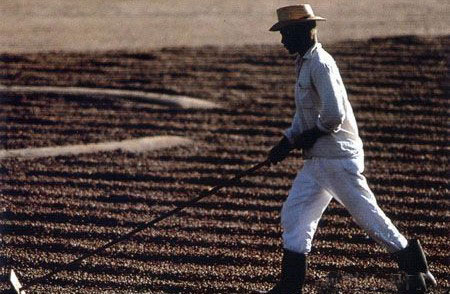
Sun-dried coffee beans [Pirajui, Sao Paulo, Brazil]
There are two ways to prepare coffee beans for the baking process. The method chosen has a significant impact on the final price and quality of coffee. The cheapest method of processing is called "drying", which is used for lower-grade coffee beans, while higher-quality coffee beans are processed by "wet treatment".
Drying is used for unwashed coffee beans. Wet treatment is used for thoroughly washed or semi-washed coffee beans. Except for the more common use of drying in Brazil and Ethiopia, most Arabica coffee beans are processed by wet treatment. In Indonesia, some Robart coffee beans are processed by wet treatment, but this is not common there.
Drying method
Drying is the cheapest, simplest and most traditional method of processing coffee beans. When processing, the harvested fruit should be spread on the cement floor, brick floor or straw mat. Ideally, the fruits should be raked flat in the sun and at regular intervals to prevent fermentation. If it rains or the temperature drops, these fruits must be covered to prevent damage.
After about 4 weeks, the water content of each fruit will drop to about 12%, when the fruit is dry. In Brazil, coffee beans at this stage are given a confusing name: coco. At this time, its skin turns dark brown and fragile, and coffee beans can be heard cackling in the shell.
The process requires more technology than it seems. Because coffee beans can be overdried, if this happens, they can easily be damaged at the next stage, when they are shelled. On the other hand, coffee beans that are not sufficiently dried are also vulnerable. The next step is to store the dried fruit in the cellar for a while. During this period, the water in fresh coffee beans continues to evaporate.
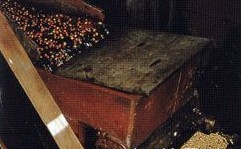
The ancient coffee bean pulp separator in Costa Rica
Wet treatment method
The wet treatment process requires more capital investment and more energy, but this method helps to ensure the quality of coffee beans and reduce damage. The main difference between the wet and dry methods is that during the wet treatment, the pulp is immediately separated from the coffee beans instead of drying them.
The pulp is separated in a separator-in a machine with a fixed surface and a movable surface, or in a machine with a movable rod, the fruit is crushed so that the pulp is separated from the coffee bean. In order to ensure the quality of coffee beans, the pulp must be separated as soon as possible after harvest, which is ideal within 12 hours, but not more than 24 hours. If the coffee beans are kept for too long, the pulp will become difficult to separate from the coffee beans, resulting in incomplete separation and possible damage to the coffee beans.
The peel and pulp separated from the coffee beans will be washed off with water. The flushing tank is designed to separate light and tender coffee beans from thick and ripe coffee beans. Such a separation can also be done by the Aagaard grader. Ogao, a coffee grower in Norway, designed a device to filter coffee beans into a large water container while growing coffee in Kenya. The large, full beans were the first to sink into the water, while the lighter ones stayed in the large container. In this process, water can be recycled.
The next step is the most basic fermentation, that is, the use of enzymes to separate the greasy glue that covers the inner pericarp. Coffee beans are stored in a fermentor for about 12 to 36 hours, which is mainly determined by the surrounding temperature, the thickness of the glue and the enzymes. When this process is completed, the endocarp around the coffee beans is no longer slippery but has a pebble-like feel.
Quality control is essential to prevent coffee tofu from rotting throughout the wet treatment, because even one rotten coffee bean can damage all coffee beans. For this reason, the equipment used must be cleaned every day to ensure that no impurities are left before the next round of processing.

Drying coffee beans on shelves (Kenya)
Sun-dried coffee beans
After the wet treatment, the coffee beans are still preserved in the inner pericarp, which still contains about 15% water. The endocarp must be dried to a moisture content of about 11% to ensure that coffee beans are stored in a stable and safe environment. Water content is critical, because if Arabica beans are overdried to a moisture content of 10%, they will lose their original turquoise and their quality will decline.
Coffee beans covered with endocarp should be laid flat on the cement floor, slate floor, dry table or plate, which is very similar to the drying method.
Mechanical dryers are sometimes used on larger plantations or where Rain Water may disrupt the drying process. Coffee beans are placed in an air-conditioning box and the dry wind blows on the surface of the coffee beans. The drying process can also be done by the sun, and coffee beans should be turned regularly to ensure complete dryness, a process that takes 12 to 15 days. The most important thing is that the endocarp should not be cracked. If the sun is too strong, the coffee beans must be covered.
At this point, the whole process is completed, coffee beans become known as "parchment coffee beans (parchment coffee)" (because the endocarp of coffee beans is quite like parchment, it is called). In general, coffee beans are kept in this form until the eve of export.
Since countries that produce coffee beans need to export coffee beans throughout the year rather than just about three months of harvest, coffee beans should be stored in the form of "parchment coffee beans" in an absolutely stable environment. High temperature is the enemy of coffee beans, and it is easy to damage coffee beans when the humidity reaches 70%. For this reason, "parchment coffee beans" are generally not stored on farms where they are produced (although there is no choice in some places). Coffee beans grown in the highlands should be stored at or near the same altitude as the places where they are grown, as they are particularly vulnerable to humidity. In this environment, Arabica coffee beans should not be stored for more than 12 hours, while Robbins coffee beans can be stored for a little longer.
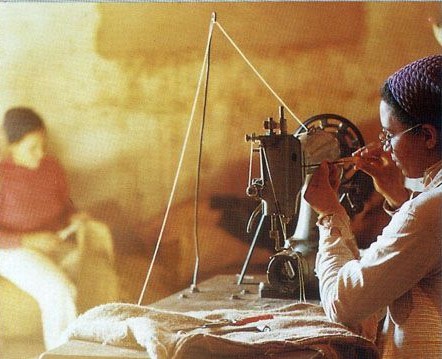
Woven coffee bag (Brazil)
Grinding or shelling
Coffee beans should be ground before they are exported, that is, the endocarp of Arabian and Robbite coffee beans to be sold should be removed. The residual shell of coffee beans after removal and cleaning of endocarp and drying process is also known as peeling or peeling.
It is more difficult to remove the endocarp of coffee beans in the wet treatment than in the drying process, so different shelling machines are needed. There are mainly two types of machines: friction sheller and compaction sheller. Engelberg and African models of friction shellers are suitable for dry or wet coffee beans: in a cylindrical box, the coffee beans are squeezed between a linear strip and a knife, and the shell is scraped by a knife to reveal the beans.
Parchment coffee beans are usually shelled on a Smout friction sheller. Jules Smout is of Belgian and Scottish descent. He was born in Koenigsberg, Prussia, and settled in Guatemala. In 1844, he developed a coffee peeling machine with a rotating body with a screw, which rotates in a box with a screw, which rotates in the opposite direction. When the coffee bean is driven along the rotation, the endocarp is peeled off the coffee bean. Because the rotating body rotates relatively slowly, it produces less heat than other types of shelling machines.
Other shellers include rolling shellers (mainly used for dried coffee beans produced in South America) and crossbar shellers (with knives inside).
In other places except Brazil, the parchment coffee beans are treated with a pressing sheller instead of rubbing the sheller. Coffee beans must have moderate water content when shelling, or they may break. The pressing sheller consists of a horizontal disk rotating in a ring, and the edge of the plate is surrounded by an iron needle or rod. When the machine is running, the coffee bean comes into contact with the iron needle due to the action of centrifugal force, which makes the endocarp shell fall off.
Polishing
The silver skin left on the coffee beans after shelling must be removed by polishing. Most polishers work in a similar way to Smoot shellers, except that copper rods are used instead of iron rods, which cause less damage to coffee beans. Copper also plated coffee beans with a charming turquoise. Coffee beans treated with a pressure sheller are usually polished because they always look more messy than those shelled by friction.
Historically, polished coffee beans have been thought to be of higher grade than unpolished coffee beans, but in fact, it makes little difference when they end up with a drink to taste in a cup. Others stubbornly believe that the value of polishing will be affected by the quality of the cup, but it is difficult to find conclusive evidence.
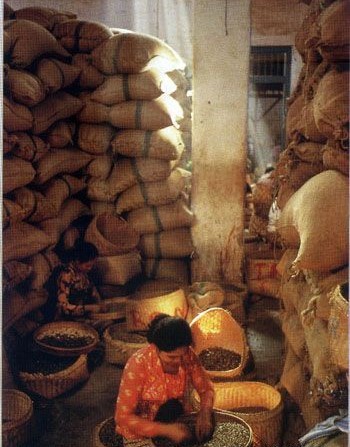
Classification of coffee beans (Brazil)
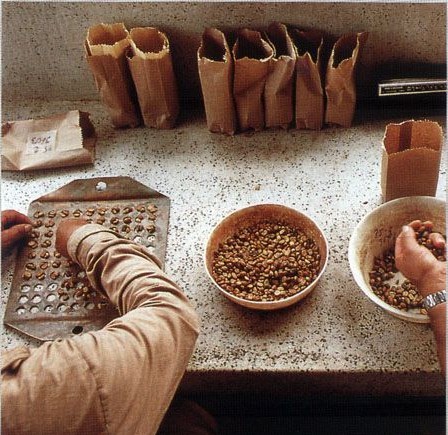
Grading of coffee beans (Colombia)
Classification and classification
Coffee beans are graded first by size and then by density. With two exceptions, all coffee beans have a considerable size and the same proportion, with flat on one side and semi-oval on the other. The special cases are pea-shaped coffee beans that tend to be more oval in shape and giant coffee beans with large particles (that is, Marragol peel coffee beans). The prices of these two kinds of coffee beans are always higher.
Generally speaking, large coffee beans can produce better coffee. Coffee beans are usually graded on a scale of 10 to 20, but in some countries coffee beans are graded according to levels corresponding to a certain size, such as AA. The way to determine the size of coffee beans is to pass them through a sieve. But even so, there may be weight differences between coffee beans of the same size: and bad, crumpled coffee beans that have to be removed will still remain.
The best way to separate unwanted coffee beans from good ones is to use gravity and air. The compressed air method is operated manually and requires higher technology. it uses jets to separate heavy and light coffee beans. Another method, the weight separation separator, is to put the coffee beans on a raised plate and let the air pass through them to make the heavy coffee beans fall. This is also a technologically demanding method, if used properly, the coffee beans can be separated more accurately and effectively.
The next step is to sort these coffee beans. Remove rotten, black, sour and overfermented or unshelled coffee beans. This process depends on eyesight, putting the beans on a moving belt to check.
Other methods include the electronic color classification (mainly used for Robbaut coffee beans) and the dichromate (bichromatic) method, which uses light detection to find bad beans. Today, however, the best test classifier is still the human eye. But there is no doubt that high-tech microprocessing systems will eventually completely replace this process.
Coffee beans are graded in different countries according to different grading systems. Some of them, such as those commonly used in Haiti, are overly complex and ineffective, while the sorting devices used in Brazil, despite their complex structure, are indeed necessary. Overall, there are six export grades, the highest of which is SHB (strictly hardbean), or Highland Coffee beans, which are produced in highlands no less than 400m above sea level.
All coffee beans must be evaluated before they are purchased. The usual practice is to buy coffee beans for self-baking instead of roasting coffee beans that have already been roasted in the place of production. The main reason is that once the coffee beans are roasted, their shelf life will be short. The second reason is that most retailers in America and Europe like to buy coffee beans directly from local roasters so that they can better control the quality of their coffee.
Important Notice :
前街咖啡 FrontStreet Coffee has moved to new addredd:
FrontStreet Coffee Address: 315,Donghua East Road,GuangZhou
Tel:020 38364473
- Prev

The "making" process of high-quality coffee beans and musk cat coffee
The production of gourmet coffee civet coffee (kopi Luwak): the process of making civet coffee is very unique. All coffee beans used to make coffee must be eaten by civets before entering the formal grinding and baking process. After the musk cat intestinal absorption, digestion and excretion before production. The coffee made by this special method is very expensive, and the current price is every
- Next

The basic knowledge of Coffee explains the picking of coffee
Coffee trees usually blossom in 3-4 years, about 2-3 months a year, and their appearance and smell are similar to those of jasmine. when they bloom, they grow in clusters on the branches and bloom for 3-5 days. After the flowers bloom, they bear small green fruits, which ripen and turn red into ripe fruits that can be picked after a few months. The skin of ripe fruit is red. Because its shape and color are similar to cherries, ripe coffee fruit is called coffee cherry in many places.
Related
- Beginners will see the "Coffee pull flower" guide!
- What is the difference between ice blog purified milk and ordinary milk coffee?
- Why is the Philippines the largest producer of crops in Liberia?
- For coffee extraction, should the fine powder be retained?
- How does extracted espresso fill pressed powder? How much strength does it take to press the powder?
- How to make jasmine cold extract coffee? Is the jasmine + latte good?
- Will this little toy really make the coffee taste better? How does Lily Drip affect coffee extraction?
- Will the action of slapping the filter cup also affect coffee extraction?
- What's the difference between powder-to-water ratio and powder-to-liquid ratio?
- What is the Ethiopian local species? What does it have to do with Heirloom native species?

